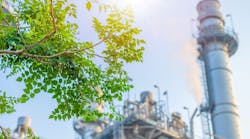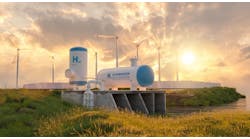To keep its 2018 promise of reducing its Scope 1 and 2 emissions by 40% by 2030, Vinci Energies in Nanterre, France, nearby Paris, organizes its sustainability efforts into three pillars: acting for the climate, working towards a circular economy, and preserving natural environments. These directives extend to the seven system integration companies it operates in North America, including Actemium industrial automation brand, Axians information and communication brand, and newly acquired Premier Automation LLC.
“Even though some companies were acquired more recently than 2018, we performed back calculations to establish baselines for each. Next, we record quarterly energy-use numbers due to electricity, natural gas and water consumed, and waste produced,” says Phillip Meyer, director of quality, health, safety, environment and IT at Vinci Energies North America. “This determines our Scope 1 and 2 performances for what we use as a company, and helps us begin to approach Scope 3 for what’s going on upstream, downstream and over applicable lifecycles.”
Actemium optimizes refrigeration, concrete processes
Meyer reports that Vinci Energies’ internal sustainability efforts help it carry over the same principles to projects it completes for its clients. Some of its Actemium projects include:
- Actemium Avanceon is working on three antiquated chillers at a plant in New Jersey, which used to run its third chiller continuously and 100% manually based on operator “feel”—and just experienced it’s third hot-standby incident. Automating all the chillers into one optimized control system allows them to operate more judiciously, and is expected to reduce their peak energy use, earn rebates, and save $300,000 per year.
- Actemium Atlantic Canada is implementing Real-Time Coefficient of Performance (RtCOP), an AI based software it developed to automate refrigeration systems. RtCOP analyzes system capacities and theoretical power consumption, continuously and in real-time, for every combination of equipment that could run in a facility. The AI application takes advantage of existing temperatures, pressures, flows and compressor curves. It’s then linked seamlessly with the existing control system using a custom PlantPAX add-on instruction. RtCOP selects equipment with the lowest calculated consumption, and optimizes setpoints to meet plant requirements with the least energy consumption. It does this 24/7 and reduces kilowatt hours (kWh) by up to 26% per year. For example, a frozen food processor in Canada implemented RtCOP, and cut its annual electricity use by almost 2.6 million kWh, which is equivalent to approximately 455 metric tons of emissions.
- Actemium Toronto created a Data Management System (DMS) for a process that produces cement-free, carbon-negative concrete. The system pulls information from more than 200 data points from Rockwell PLCs managing temperature sensors, humidity sensors, drying timers, cooling timers and other devices. These are combined with more than 100 manually entered values and more than 100 calculated values to give the client information from dashboards to trend graphs to alarm status. The system gives the client the information required to verify the amount of carbon sequestered in the concrete it produces.
“Our leadership is committed to reducing our Scope 1 and 2 emissions by 40% based on 2018 figures, but sustainability also represents big efficiencies and savings in materials, power and logistics,” explains Meyer. “Many clients want to get in on those savings, too.”
Software aids sustainability savings
Just as it’s crucial to include control strategies, cybersecurity and other performance attributes into automation projects before they’re designed and developed, Meyer stresses that sustainability must be on the same list.
“Vinci Energies’ Axians brand has created software for assessing the estimated carbon footprint of a given project, which must be provided in much of Europe,” says Meyer. “It also points out details, including potential CO2 savings. For example, instead of shipping infrastructure servers and switches for a light-rail project in Toronto from New Jersey to Italy for factory acceptance testing (FAT), it shows approximately how much CO2 and revenue can be saved by sending the equipment directly from New Jersey to Toronto, and performing the FAT remotely at the client’s site.”
Meyer adds that savings calculations like these will become increasingly important for evaluating future sustainability plans and projects. This is because he reports that green business activity is expected to multiply four to 10 times by 2030, and participants need some way to assess and compare which proposals will be the most beneficial.
“All of these projects will require automation to be efficient, but they’ll also need to determine which controls will be the most appropriate and useful because many PLCs and other devices are becoming increasingly obsolete,” adds Meyer. “As usual, buy-in and investment from leadership will be vital to reaching net-zero targets and other sustainability goals. However, it will be just as crucial for managers to give their people chances to exercise their creativity when developing and applying sustainability solutions. There are many young people who are very interested in this, and they must be encouraged and given time to see what they can do with software and other tools that can reduce CO2 emissions and save money at the same time. In fact, Vinci, the holding company of Vinci Energies, already sponsors environmental awards for its staffers, who can submit sustainability ideas, and compete to win prizes to help develop and disseminate their environmental projects.”
Latest from Sustainability
Latest from Sustainability





